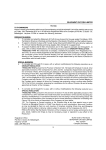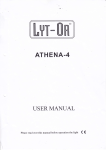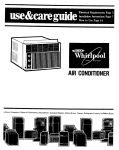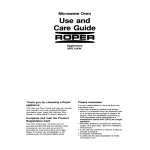Download Whirlpool RGH 8300-2 User's Manual
Transcript
RGH 8300-l '% RGHt!S3m-25 .. TO INSTALL RANGE This unit can be vented vertically through uoper cabine!s or horrzontally through an outside wall. A typical vertical installet~on iS shown in Figure 1. A ryolcal horizonial rnstallatron IS shown In Figure 2. For proper ventila:ron when used wrth an indoor electrrc grill. see paoe 2 for gurctelines for proper auct sizing. Improper duct sizing or ins:alletion of restrictive roof jacks can reduce air moving capacity and provide inadequate ventilation for an indoor electric grill. For mcst efficient smoke removal, the top of the hood should be approximately 56 Inches (13T.6 cm) from the floor. 1. Make a template or transfer measurements shown in Fig. 3 to cabinets or wall. 2. Cut holes to accomodate ventilating duct allowing ‘4” (-6 cm) clearance on all 4 srdes for back vent. Allow !.” (1.9 cm) clearance toward front for vertical vent. A!low I%” (.6 cm) on other3 sides for top vent. 3. Cut appropriate hole for electrical wiring. 4. Run wire through wall or cabinets according to Nattonal Electrical Code and applrcable local codes. (DO NOT turn power on until installation is complete.) 5, For an easrer rnstallaiion. remove the filters and the three assembltes shown in Frg. 4. Thus reduces the weight about 40%. The blower cover and light frame assembly are held into place with thumb screws. To romove the blower assembly, first unplug the blower power supply cord f:om the junction box. Remove the packing screw from the b!ower retarnrno rod. then pull the blower retalntng rod to one side. freeing it from between the bumps on the blower housing. 6. Remove screw holding junction box cover. 7. Remove proper electrical knockout, See Figure 3. 8. Remove proper venting knockout. See Figure 3. NOTE: If horizonta! discharge is selected an additronal knockout in the blower cradle must be removed. 9. Attach !he damoer as shown in Figure 5 for vertical discharge or Fig. 6 for horizontal discharge. 10. Lift the hood into position. Mark location of four mounting holes. 11. Remove hood and start all four screws in center of narrow neck of keyhole slot marked on cabmet bottom. 72. Lift the hood into posrrion simultaneously feeding the electrical wire through the knockout. Fojlow aoplicable local codes and/or latest Nattonal Electrrcal Code for electrical connector to be used at field wiring entrance. 13. Tighten screws to secure hood. Be sure screw head is in narrow neck of keyhole slot. 14. Install proper duct work. See page 2. 16. COmplete electrical wiring -in junction box according to the National Electrical Code and applicable Local Codes. NOTE: This Unit must be permanently grounded in accordance with the National Electrical Code and applrcable Local codes. 16. Replace junction box cover, 17. Replace blower. See page 3 for proper blower orientation 18. Replace blower cover. light frame assembly and filters. NOTE: It has been found that a large part of the energy loss of the average home IS due to outslde air InfIltratIng the structure, Sea) around duc!work wncre It passes through outside walls or ceilrng. Sea-l around electrical wrrrng also. L4 HOOD FIGURE 2 . . FIGURE L V,lPil,G-,:.r,:*=w; 3 ,-LIGHT FRAME \ i "I ,/-9LOWER RETAINING ROD - J’JYCTION 90x . COVER -BLOWER CRADLE FIGURE 4 . \ . CAMPER BLADE TO FRONT ’ . b FIGURE . 5 FIGURE Guideline to Proper Duct Sizing for Ventilating An Indoor 6 Electric Grill These Guidelines are to insure adequate ventilation for an indoor Electric Grill. Indoor electnc grills produce more smoke than normal cooking and requtres at least 41 O CFM to provide adequate ventllatton. Less sinngent venttlating requtrements can deviate from these recommendations. HORIZONTAL VENTING: Frgure 2 on page 1 shows a direct discharge to the outside through a wall rain cap. Due to the lower CFM rating in this venting posItron. duct must be limtted to a maximum of 2 feet of 3;/r x 10 Inch duct capped with a wall rain cap with a free discharge area of al least 66 inches square. There should be no bends in the connec:lng duct between the hood and the wall ratn cap. VERTICAL VENTING: Figure 1 on page 1 shows an installation using 3 feet of 3% x 10 inch duct term:nating in a roof rain cap. In table 1 we see that 3 feet of 3:. x 10 inch duct is the maxlmum lengtn of 3’;; x 10 Inch duct recommended. Figure 7 shcws an installation requiring more duct length. A transr!lon to round is used as close to the hood as possible to elrmtnate the restriction caused by the 3’; x 10 duct. 4jJ bends should be used Instead of 90g bends wherever possible. For example, if the straight lengihs of duct In FIN. 7 total 9 ft. the elbow IS 45’ and the roof rain cap has 113 in’ free area. choose the duct size required. The -15; elbow can be approximated by dividing the equivalent duct !engths In Table 2 by two. Since we already have9 ft. of straight dia. IS too small. So we try 8” dia. 9 ft. Straight Duct 6 Equrvalent straight length 15 ft. duct, Table 1 tells us that 7” of 4.Y elbow (8” Dia.) FIGURE Frfteen feet is ever the maximum of 13 ft. for 8” dia. duct, so 8” duct IS to small. !-dove to 9” dia. duct and run :hrough the calculations again. 9 ft. Straight Duct. 7 ft. Equrvalent stratght i-6-K Sixteen fee! duct IS a gocd leng!h under the maxrmum chotce. IS CFM vs. DUCT LENGTH FOR F?GH SERIES Equivalent Duct Length (ft.) Static Pressure cf 9” dia. duct for 45” elbow. Duct Size I 3’/. x 10” ,uax Duct Length (Feet) I of 25 ft. for 9” dia. duct, so 9” 7” dm I 8” dia. I 9” dia. 13 1 10” dia. 1 25 j 3-;;t:0 / 7” dia. 460 .lO 440 .15 417 / 390 4 I 7 i 12 / 18 1 HOOD 1 8” dia. 1 9” dia.1 L I 8.5 17 16.0 31 25.0 50 40 1 77 4 ~~~ : 30 i 55.5 1 / 142! 40 .25 Table 1 shows the maxlmum length of duct to be used In COnjunct;on wltn a roof rain cap i-,avlng a free area of 113 II-I?. TABLE cFh4 .06 .20 7. 3 / I TABLE I Vertical Venting I 7 355 330 2 I . -- 90” . Elbow l Duct Size Equivalent length of straight ducr of same dia. 9” dia. 10” dta. 11 12 14 :6 ft. ft. ft. ft. .30 250 65 1 1361 .35 180 ?40 i .; -I c NOTE: Tne above table IS basec on-~ertlcal disc IT&?. Thevaiues In lhls !able are for duct length only and co not account for Sldtic pressure loss :hroucn roof mounted rain c. 0s RANGE HOOD BLOWER ORIENTATION . NOTE: Before c!zmper for free any restrictlons for proper duct Correct Blower crientation is imperative Incorrec! installation will drasticallv cut air flow and cause Blower IO run a! maximum RPM regardless Of motor speed control Seitlilg. VERTICAL . DISCHARGE: 1. Figure 1 shows vertical discharge. the proper Blower Assembly 2. From tire Blower positlon shown in Figure Assembly vertically Into mounting positton. orientation for BLDWER DISCHPRZE ~o’,&lE GT DISCHARGE VENT IN TOP OF HO30 1 lift the Blower - 3. The 3” Blower discharge surface should’ now be flush against top of hood. This will allow proper ai:flowfrom the alower through the top ven:. (The wider 5” surface will be to the rear). HORIZONTAL 1. Figure horizontal DISCHARGE: 2 shows the proper discharge. FIGURE Blower 2. From the Blower position shown Assembly vertically into positlon. Assembly In Figure orientation for ’ l reinstalling the Blower Assembly check the operation. Open the damper bla?e a?d check for in the duct system. Check Instaliailon InstructIons sizing. VERTICAL I DISCHARGE 2, lift the Blower 3. The 3” Blower discharge surface should now be flush against rear of hood. This wail aliow proper air f!ov: from the Blower through the rear vent. (The wider 5’. surface WIII be to the top). THIS SURFACE aLowER To TOP DISCHARGELOCATE AT DtSCHARGE VENT IN REAR 0~ HOCD FIGURE HORIZONTAL 2 DISCHARGE OPEZATION . BLOWER AND CARE OF UNIT CARE OF FILTER CONTROL This range hcod has a solid allows an lnfrnlte control of ’ 440 CFM down. Afier setting ’ will take approx. 15 seconds setting. state motor speed control. This blower air moving capacity from the control !o a desired speed, it for the blower to respond to that For greatest efficiency, the permanent aluminum filter shouid be removed and c!eaned perrodically. The filter can be washed in a dishwasher. CARE OF EXTERIOR CARE OF BLOWER Under normal operating conditions. this blower requires no otiing for the first year. Af:er the first year 011 every 6 months with SAE 20 oil. LIGHT S’r’IITCH Select two light bulbs lignting level. Whl~lpool Iranchis.;d up to 75 TECH-CARE watis each to achieve dnslred Replacement filters and Whirlpool Corporation Indiana 46350. For most turn on fan at beginning until smoke & cdors are servlce Ranap ?.,rc?.ase .- repair parts may be obtained from Parts Distribution Center, La Porte, ef!ective removal of smoke 8 odors: of cooking operation 8 allow to run removed from room. - service h,ly TECH-CAZE - SURFACE5 Your range hood is a beautifully finished addition to your kitchen. To preserve its lasting beauty, clean with a mild detergent. DO NOT use abrasive cleaners. ,.;. s telephone reDreseh!3ilve 200~ and mcdel numoer’ c!r Insla!lallon c!cale wmber IS











